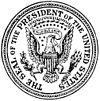 | |
| Presidency of Calvin Coolidge August 2, 1923 – March 4, 1929 | |
| Cabinet | See list |
|---|---|
| Party | Republican |
| Election | 1924 |
| Seat | White House |
|
| |
| Library website | |
| ||
|---|---|---|
|
48th Governor of Massachusetts
30th President of the United States
Vice Presidential and Presidential campaigns
Post-presidency
 |
||
Calvin Coolidge's tenure as the 30th president of the United States began on August 2, 1923, when Coolidge became president upon Warren G. Harding's death, and ended on March 4, 1929. A Republican from Massachusetts, Coolidge had been vice president for 2 years, 151 days when he succeeded to the presidency upon the sudden death of Harding. Elected to a full four–year term in 1924, Coolidge gained a reputation as a small-government conservative. Coolidge was succeeded by former Secretary of Commerce Herbert Hoover after the 1928 presidential election.
Coolidge adeptly handled the aftermath of several Harding administration scandals, and by the end of 1924 he had dismissed most officials implicated in the scandals. He presided over a strong economy and sought to shrink the regulatory role of the federal government. Along with Secretary of the Treasury Andrew Mellon, Coolidge won the passage of three major tax cuts. Using powers delegated to him by the 1922 Fordney–McCumber Tariff, Coolidge kept tariff rates high in order to protect American manufacturing profits and high wages. He blocked passage of the McNary–Haugen Farm Relief Bill, which would have involved the federal government in the persistent farm crisis by raising prices paid to farmers for five crops. The strong economy combined with restrained government spending produced consistent government surpluses, and total federal debt shrank by one quarter during Coolidge's presidency. Coolidge also signed the Immigration Act of 1924, which greatly restricted immigration into the United States. In foreign policy, Coolidge continued to keep the United States out of membership or major engagement with the League of Nations. However he supported disarmament agreements and sponsored the Kellogg–Briand Pact of 1928 to outlaw most wars.
Coolidge was greatly admired during his time in office, and he surprised many by declining to seek another term. Public opinion on Coolidge soured shortly after he left office as the nation plunged into the Great Depression. Many linked the nation's economic collapse to Coolidge's policy decisions, which did nothing to discourage the wild speculation that was going on and rendered so many vulnerable to economic ruin. Though his reputation underwent a renaissance during the Ronald Reagan administration, modern assessments of Coolidge's presidency are divided. He is adulated among advocates of smaller government and laissez-faire; supporters of an active central government generally view him less favorably, while both sides praise his support of racial equality.[1]
© MMXXIII Rich X Search. We shall prevail. All rights reserved. Rich X Search



